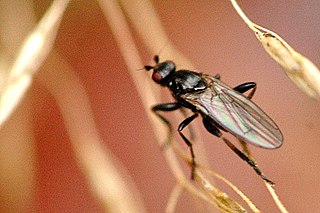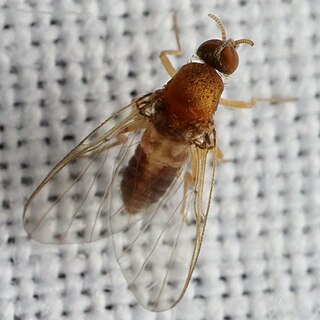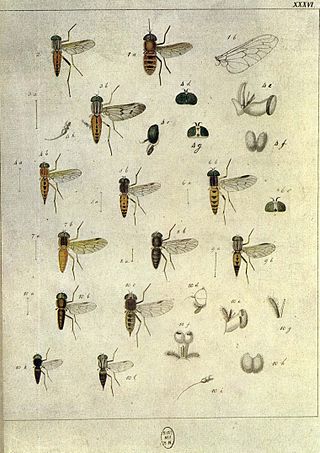
A black fly or blackfly is any member of the family Simuliidae of the Culicomorpha infraorder. It is related to the Ceratopogonidae, Chironomidae, and Thaumaleidae. Over 2,200 species of black flies have been formally named, of which 15 are extinct. They are divided into two subfamilies: Parasimuliinae contains only one genus and four species; Simuliinae contains all the rest. Over 1,800 of the species belong to the genus Simulium.

Sphaeroceridae are a family of true flies in the order Diptera, often called small dung flies, lesser dung flies or lesser corpse flies due to their saprophagous habits. They belong to the typical fly suborder Brachycera as can be seen by their short antennae, and more precisely they are members of the section Schizophora. There are over 1,300 species and about 125 genera accepted as valid today, but new taxa are still being described.

The Micropezidae are a moderate-sized family of acalyptrate muscoid flies in the insect order Diptera, comprising about 500 species in about 50 genera and five subfamilies worldwide,. They are most diverse in tropical and subtropical habitats, especially in the Neotropical Region.

The Pyrgotidae are an unusual family of flies (Diptera), one of only two families of Cyclorrhapha that lack ocelli. Most species are "picture-winged", as is typical among the Tephritoidea, but unlike other tephritoids, they are endoparasitoids; the females pursue scarab beetles in flight, laying an egg on the beetle's back under the elytra where the beetle cannot reach it. The egg hatches and the fly larva enters the body cavity of the beetle, feeding and eventually killing the host before pupating. In the United States, some species of Pyrgota and Sphecomyiella can be quite common in areas where their host beetles are abundant. Like their host beetles, these flies are primarily nocturnal, and are often attracted to artificial lights.

Gigantodax is a genus of 68 species of black flies distributed along the Andes from Mexico to Tierra del Fuego in Argentina.

Pangonius is a genus within the horse-fly family (Tabanidae), often misspelled as Pangonia; Latreille originally published the name as Pangonius in 1802, emending it in 1804 to Pangonia, but the emendation is not valid under the International Code of Zoological Nomenclature. Some species that were earlier placed in this genus are now in the genus Philoliche.

The Simuliini is a tribe of black flies that contains over 2,000 species, with more than 1,800 in the genus Simulium. There are 19 living genera, and three genera only known from Cretaceous fossils.

Simuliinae is a subfamily of black flies (Simuliidae). It contains over 2,200 species, with over 1,800 of them in the genus Simulium. There are 2 tribes and 25 living genera. A further 5 genera are known only from Cretaceous fossils.
Prosimuliini is a tribe of black flies. It contains over 140 living species, with more than a half of them in the genus Prosimulium. There are 6 living genera, and 2 genera that are only known from Cretaceous fossils.
Cnephia is a genus of 9 species of black flies. They are distributed in scattered locations across the Northern Hemisphere, from Ukraine to Eastern Siberia, and some parts of North America.
Araucnephia is a genus of South American black flies from Chile and Argentina. There are only 2 known species.

Austrosimulium is a genus of 31 species of black flies that are distributed in Australia and New Zealand. There are 2 subgenera: Austrosimulium whose species are principally from New Zealand, and Novaustrosimulium which are exclusively Australian. Austrosimulium is a sister genus to the monospecific Paraustrosimulium of South America.
Ectemnia is a genus of 4 species of black flies. They are distributed in North America.

A gnat is any of many species of tiny flying insects in the dipterid suborder Nematocera, especially those in the families Mycetophilidae, Anisopodidae and Sciaridae. Most often they fly in large numbers, called clouds. "Gnat" is a loose descriptive category rather than a phylogenetic or other technical term, so there is no scientific consensus on what constitutes a gnat. Some entomologists consider only non-biting flies to be gnats. Certain universities and institutes also distinguish eye gnats: the Smithsonian Institution describes them as "non-biting flies, no bigger than a few grains of salt, ... attracted to fluids secreted by your eyes".

Austrosimulium is a subgenus of Austrosimulium, a genus of Simuliidae. The flies in this subgenre are found mainly in New Zealand, with a few in Australia. They are the only Simuliidae found in New Zealand.
Stegopterna is a genus of black flies. There are about 15 described species in Stegopterna.
Morinia is a genus of flies in the family Polleniidae.
Françoise Beaucournu-Saguez was a French entomologist who specialized in blackfly research.













